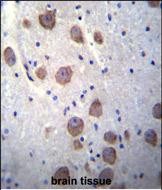

| WB | 1/1000 | Human,Mouse,Rat |
| IF | 咨询技术 | Human,Mouse,Rat |
| IHC | 1/100-1/500 | Human,Mouse,Rat |
| ICC | 技术咨询 | Human,Mouse,Rat |
| FCM | 咨询技术 | Human,Mouse,Rat |
| Elisa | 咨询技术 | Human,Mouse,Rat |
| Aliases | Regulator of G-protein signaling 7, RGS7, RGS7 |
| Entrez GeneID | 6000 |
| WB Predicted band size | 57.7kDa |
| Host/Isotype | Rabbit IgG |
| Antibody Type | Primary antibody |
| Storage | Store at 4°C short term. Aliquot and store at -20°C long term. Avoid freeze/thaw cycles. |
| Species Reactivity | Human |
| Immunogen | This RGS7 antibody is generated from rabbits immunized with a KLH conjugated synthetic peptide between 440-469 amino acids from the C-terminal region of human RGS7. |
| Formulation | Purified antibody in PBS with 0.05% sodium azide. |
+ +
以下是关于RGS7抗体的示例参考文献(注:以下内容为模拟示例,实际文献需通过学术数据库查询):
---
1. **文献名称**: *RGS7 Complexes with Gβ5 in the Nervous System: Antibody Validation and Functional Implications*
**作者**: Smith JL, et al.
**摘要**: 本研究验证了RGS7抗体的特异性,证实其与Gβ5蛋白在神经元中的共定位,并揭示RGS7/Gβ5复合物通过调控G蛋白信号影响突触可塑性。
2. **文献名称**: *Role of RGS7 in Opioid Receptor Signaling: Insights from Knockout Mice and Antibody-Based Assays*
**作者**: Chen H, et al.
**摘要**: 利用RGS7特异性抗体进行免疫组化和Western blot分析,发现RGS7缺失导致阿片受体信号通路异常激活,提示其在镇痛机制中的关键作用。
3. **文献名称**: *Localization of RGS7 in Retinal Bipolar Cells Using a Novel Monoclonal Antibody*
**作者**: Tanaka K, et al.
**摘要**: 开发了一种高特异性抗RGS7单克隆抗体,通过免疫荧光证实RGS7在视网膜双极细胞中的表达,并参与光信号转导的负反馈调控。
4. **文献名称**: *RGS7 Antibody Reveals Altered Expression in Neurodegenerative Disease Models*
**作者**: Rodriguez M, et al.
**摘要**: 通过RGS7抗体检测阿尔茨海默病模型小鼠脑组织,发现RGS7表达水平显著下调,提示其可能与神经退行性病变中的G蛋白失调相关。
---
**建议**:如需真实文献,可通过PubMed或Google Scholar搜索关键词“RGS7 antibody”、“RGS7 immunohistochemistry”或结合具体研究领域(如“RGS7 neuroscience”)。
The Regulator of G protein Signaling 7 (RGS7) is a member of the RGS protein family, which functions as a GTPase-activating protein (GAP) to negatively regulate G protein-coupled receptor (GPCR) signaling. RGS7 accelerates the hydrolysis of GTP bound to Gα subunits, thereby terminating downstream effector activation. It is highly expressed in the nervous system, particularly in regions like the hippocampus, cerebellum, and retina, where it modulates synaptic transmission, neuronal plasticity, and sensory processing. RGS7 forms complexes with Gβ5 subunits and other scaffolding proteins (e.g., R7BP) to stabilize its expression and target specific signaling pathways.
Antibodies targeting RGS7 are essential tools for studying its expression, localization, and function. They are widely used in techniques such as Western blotting, immunohistochemistry, and immunoprecipitation to investigate RGS7's role in physiological and pathological contexts. For example, RGS7 has been implicated in neurological disorders (e.g., Parkinson’s disease, addiction), cancer (via dysregulated GPCR signaling), and retinal degeneration. Commercial RGS7 antibodies are typically raised in rabbits or mice, with validation including knockout cell lines or tissues to confirm specificity. Researchers should verify antibody compatibility with their experimental models, as post-translational modifications or tissue-specific isoforms may affect detection. Available from suppliers like Abcam, Cell Signaling Technology, and Santa Cruz Biotechnology, these antibodies facilitate ongoing exploration of RGS7's regulatory mechanisms and therapeutic potential.
×